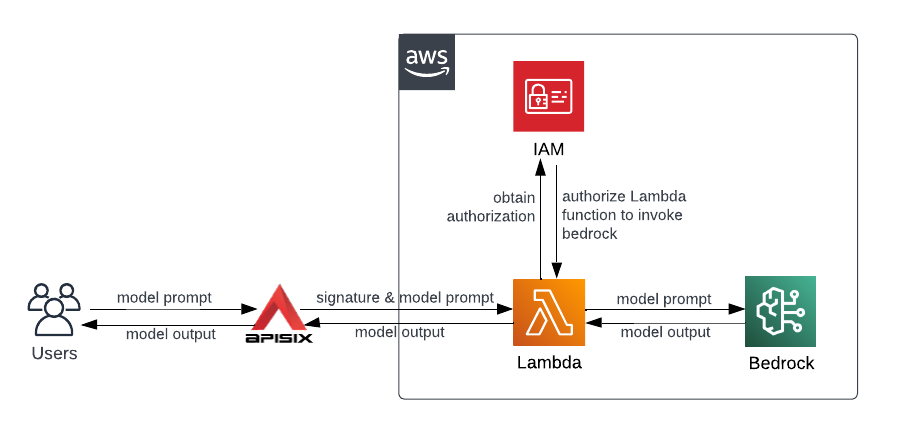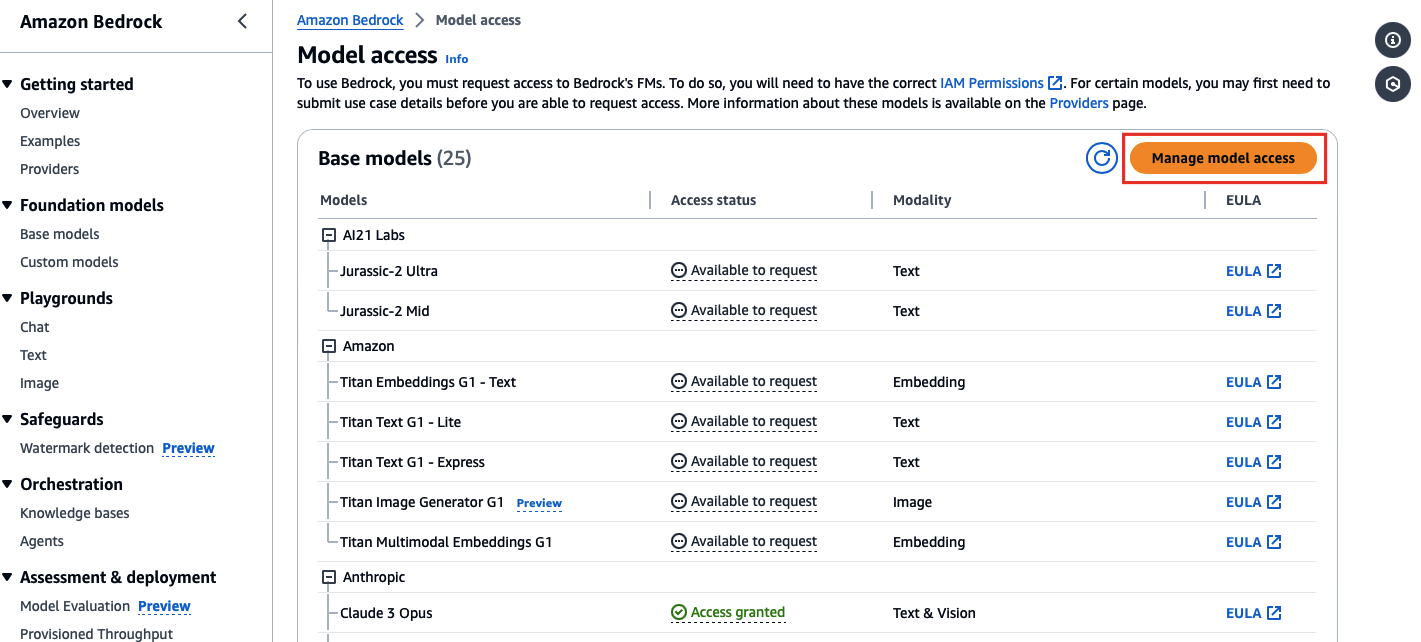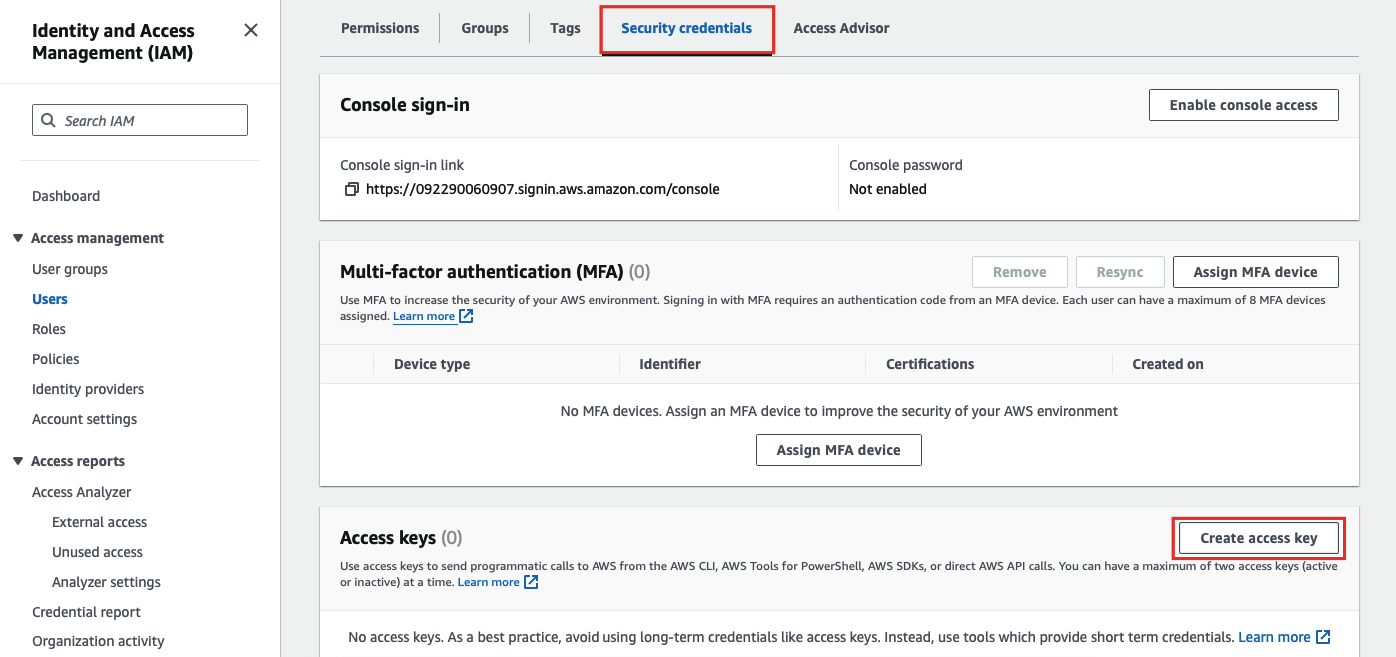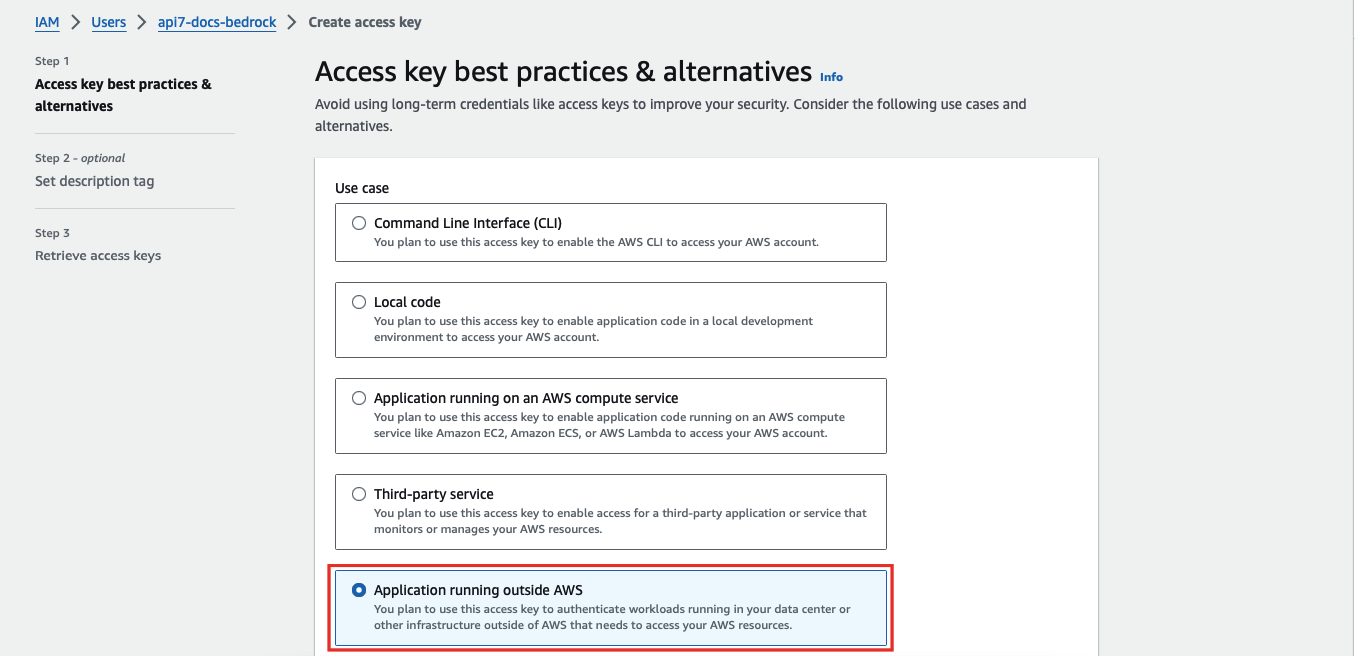Proxy Amazon Bedrock Requests
Amazon Bedrock is a fully managed service that offers a wide range of high-performing foundation models (FMs) from leading AI companies such as Anthropic, AI21 Labs, Cohere, Meta, Mistral AI, Stability AI, and Amazon. These models are made available through Bedrock in a single API, empowering organizations to build cutting-edge AI solutions with ease.
This guide will walk you through the process of integrating APISIX with Amazon Bedrock. You will be setting up a Lambda function on AWS to interact with Claude 3 Opus model on Bedrock, configuring the necessary Identity and access management (IAM) permissions, and creating an APISIX route to the function URL using the aws-lambda plugin, which implements AWS Signature Version 4.

Prerequisite(s)
- Have an AWS account and log in as an IAM user.
- Install Docker.
- Install cURL to send requests to the services for validation.
- Follow the Getting Started Tutorial to start a new APISIX instance in Docker or on Kubernetes.
Select Foundation Models (FMs)
Log into your AWS console, go to the Amazon Bedrock service, and request access for one or more models you would like to integrate with:

The following document will use Anthropic Claude 3 Opus model as an example. Note that not all models are available in all regions. At the time of writing, Anthropic Claude 3 Opus is only available in us-west-2. See model regions for reference and adjust your AWS account region as needed.
Create IAM Access Keys
Go to AWS Identity and Access Management (IAM) and select the user account you would like to use for integration:

In the security credentials tab, select create access key:

Select application running outside AWS as the use case:

Continue the credential creation and note down the access key and secret access key:

Create Lambda Function
Go to AWS Lambda and create a new function with Node.js runtime. You can also choose other runtime and write your own code.
Develop Function Code
Paste the following code into the Lambda function:
import { BedrockRuntimeClient, InvokeModelCommand } from "@aws-sdk/client-bedrock-runtime";
// replace with your model information
const aws_region = "us-west-2";
const model_id = "anthropic.claude-3-opus-20240229-v1:0"
const anthropic_version = "bedrock-2023-05-31"
// create a bedrock client in the selected region
const bedrockClient = new BedrockRuntimeClient({ region: aws_region });
export const handler = async (event) => {
// get model prompt from model_input in the request body
const requestBody = JSON.parse(event.body);
const model_input = requestBody.model_input;
// put together model parameters
const params = {
modelId: model_id,
contentType: "application/json",
accept: "application/json",
body: JSON.stringify({
anthropic_version: anthropic_version,
max_tokens: 2048,
messages: [{
role: "user",
content: `${model_input}`
}]
})
}
// attempt sending requests to bedrock
const cmd = new InvokeModelCommand(params);
try {
const resp = await bedrockClient.send(cmd);
const textDecoder = new TextDecoder("utf-8");
const resp_body = JSON.parse(textDecoder.decode(resp.body));
return resp_body.content[0].text;
} catch (err) {
console.error("Error invoking Bedrock:", err);
throw err;
}
};
This function accepts a model prompt from a user input model_input in the request body.
Configure Function Permission
In this step, you will attach the needed permission to the Lambda function so that it can invoke Bedrock models.
Go to the Configuration tab of the Lambda function and under Permissions, click on the role name to open the IAM page for the function:

Click on the Add permissions dropdown and select Create incline policy:

Add the following policy to the policy editor and save:
{
"Version": "2012-10-17",
"Statement": [
{
"Effect": "Allow",
"Action": [
"bedrock:InvokeModel"
],
"Resource": "*"
}
]
}
This allows the Lambda function to invoke Bedrock models only without provisioning the full permissions.
Adjust Function Timeouts
By default, Lambda function times out in 3 seconds, and it is sometimes it is not sufficient time for model to process user requests and respond back.
To increase the timeout value, go to the Configuration tab of the Lambda function and under General configuration, edit the timeout to a larger value, such as 30 seconds:

Create Function URL
To integrate with the Lambda function, the function should have a public URL. Go to the Configuration tab of the Lambda function and under Function URL, create a function URL:

Configure APISIX
Create a route in APISIX and configure the aws-lambda plugin:
- Admin API
- ADC
- Ingress Controller
curl "http://127.0.0.1:9180/apisix/admin/routes" -X PUT -d '
{
"id": "aws-bedrock",
"uri": "/bedrock-claude",
"plugins": {
"aws-lambda": {
"function_uri": "https://jbihqn4bfwewf4nfrz6typjmcvjh40iuamw.lambda-url.us-west-2.on.aws/",
"authorization": {
"iam": {
"accesskey": "AKIARK7HKSJVWCOIIMW6",
"secretkey": "7vb0dmaYP4afRpvtQJ9Tloija729s2g4moUdIdr8",
"aws_region": "us-west-2",
"service": "lambda"
}
},
"timeout": 30000,
"ssl_verify": false
}
}
}'
❶ Replace with your Lambda function URL.
❷ Replace with your IAM access key.
❸ Replace with your IAM secret access key.
❹ Set to the AWS region of your Lambda function.
❺ Set to the service receiving the request.
❻ Configure timeout in milliseconds.
services:
- name: Amazon Bedrock Service
routes:
- uris:
- /bedrock-claude
name: bedrock-claude
plugins:
aws-lambda:
function_uri: 'https://jbihqn4bfwewf4nfrz6typjmcvjh40iuamw.lambda-url.us-west-2.on.aws/'
authorization:
iam:
accesskey: AKIARK7HKSJVWCOIIMW6
secretkey: 7vb0dmaYP4afRpvtQJ9Tloija729s2g4moUdIdr8
aws_region: us-west-2
service: lambda
timeout: 30000
ssl_verify: false
❶ Replace with your Lambda function URL.
❷ Replace with your IAM access key.
❸ Replace with your IAM secret access key.
❹ Set to the AWS region of your Lambda function.
❺ Set to the service receiving the request.
❻ Configure timeout in milliseconds.
Synchronize the configuration to APISIX:
adc sync -f adc.yaml
Create a Kubernetes manifest file to configure a route:
- Gateway API
- APISIX CRD
apiVersion: apisix.apache.org/v1alpha1
kind: PluginConfig
metadata:
namespace: ingress-apisix
name: aws-plugin-config
spec:
plugins:
- name: aws-lambda
config:
function_uri: https://jbihqn4bfwewf4nfrz6typjmcvjh40iuamw.lambda-url.us-west-2.on.aws/
authorization:
iam:
accesskey: AKIARK7HKSJVWCOIIMW6
secretkey: 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
aws_region: us-west-2
service: lambda
timeout: 30000
ssl_verify: false
---
apiVersion: gateway.networking.k8s.io/v1
kind: HTTPRoute
metadata:
namespace: ingress-apisix
name: bedrock-claude
spec:
parentRefs:
- name: apisix
rules:
- matches:
- path:
type: Exact
value: /bedrock-claude
filters:
- type: ExtensionRef
extensionRef:
group: apisix.apache.org
kind: PluginConfig
name: aws-plugin-config
apiVersion: apisix.apache.org/v2
kind: ApisixRoute
metadata:
namespace: ingress-apisix
name: bedrock-claude
spec:
ingressClassName: apisix
http:
- name: bedrock-claude
match:
paths:
- /bedrock-claude
upstreams:
- name: amazon-bedrock-upstream
plugins:
- name: aws-lambda
enable: true
config:
function_uri: https://jbihqn4bfwewf4nfrz6typjmcvjh40iuamw.lambda-url.us-west-2.on.aws/
authorization:
iam:
accesskey: AKIARK7HKSJVWCOIIMW6
secretkey: 7vb0dmaYP4afRpvtQJ9Tloija729s2g4moUdIdr8
aws_region: us-west-2
service: lambda
timeout: 30000
ssl_verify: false
❶ Replace with your Lambda function URL.
❷ Replace with your IAM access key.
❸ Replace with your IAM secret access key.
❹ Set to the AWS region of your Lambda function.
❺ Set to the service receiving the request.
❻ Configure timeout in milliseconds.
Apply the configurations to your cluster:
kubectl apply -f bedrock-claude-route.yaml
Verify
Send a request to the route with a prompt in the request body:
curl -i "http://127.0.0.1:9080/bedrock-claude" -X POST \
-H "Content-Type: application/json" \
-d '{"model_input": "Write a 50 word introduction of Frida Khalo"}'
You should receive an HTTP/1.1 200 OK response with the model output:
Frida Kahlo (1907-1954) was a Mexican artist known for her striking self-portraits and vivid expressions of pain, resilience, and identity. Despite facing numerous challenges, including a devastating bus accident and a turbulent marriage to fellow artist Diego Rivera, Kahlo's unique style and powerful imagery have made her an iconic figure in art history.
Next Steps
You have now learned how to integrate APISIX with Amazon Bedrock FMs.
If you would like to proxy streamed responses from Amazon Bedrock, you can use the proxy-buffering plugin to disable NGINX's proxy_buffering directive to avoid server-sent events (SSE) being buffered.
Additionally, you can integrate more capabilities that APISIX offers, such as rate limiting and caching, to regulate API usage and improve user experience.